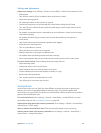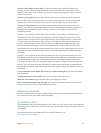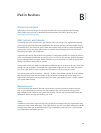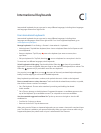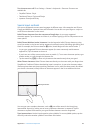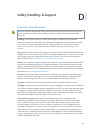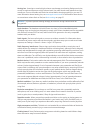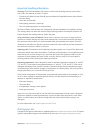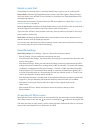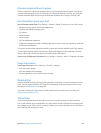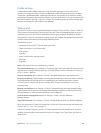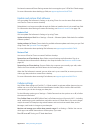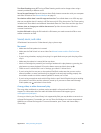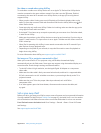
Appendix D Safety, Handling, & Support 124
Hearing loss Listening to sound at high volumes may damage your hearing. Background noise,
as well as continued exposure to high volume levels, can make sounds seem quieter than they
actually are. Turn on the audio and check the volume before inserting anything in your ear. For
more information about hearing loss, see www.apple.com/sound. For information about how to
set a maximum volume limit on iPad, see Music settings on page 57.
WARNING: To prevent possible hearing damage, do not listen at high volume levels for
long periods.
Apple headsets The headsets sold with iPhone 4s or later in China (identiable by dark
insulating rings on the plug) are designed to comply with Chinese standards and are compatible
with iPhone 4s or later, iPad 2 or later, and iPod touch 5th generation. Use only compatible
headsets with your device.
Radio signals iPad uses radio signals to connect to wireless networks. For information about
the amount of power used to transmit these signals, and about steps you can take to minimize
exposure, see Settings > General > About > Legal > RF Exposure.
Radio frequency interference Observe signs and notices that prohibit or restrict the use of
mobile devices (for example, in healthcare facilities or blasting areas). Although iPad is designed,
tested, and manufactured to comply with regulations governing radio frequency emissions, such
emissions from iPad can negatively aect the operation of other electronic equipment, causing
them to malfunction. Turn o iPad or use Airplane Mode to turn o the iPad wireless transmitters
when use is prohibited, such as while traveling in aircraft, or when asked to do so by authorities.
Medical devices iPad contains radios that emit electromagnetic elds. These electromagnetic
elds may interfere with pacemakers or other medical devices. If you wear a pacemaker, maintain
at least 6 inches (approximately 15 cm) of separation between your pacemaker and iPad. If you
suspect iPad is interfering with your pacemaker or any other medical device, stop using iPad and
consult your physician for information specic to your medical device. iPad has magnets along
the left edge of the device and on the right side of the front glass, which may interfere with
pacemakers, debrillators, or other medical devices. The iPad Smart Cover and iPad Smart Case
also contain magnets. Maintain at least 6 inches (approximately 15 cm) of separation between
your pacemaker or debrillator and iPad, the iPad Smart Cover, or the iPad Smart Case.
Medical conditions If you have any medical condition that you believe could be aected by iPad
(for example, seizures, blackouts, eyestrain, or headaches), consult with your physician prior to
using iPad.
Explosive atmospheres Do not charge or use iPad in any area with a potentially explosive
atmosphere, such as at a fueling area, or in areas where the air contains chemicals or particles
(such as grain, dust, or metal powders). Obey all signs and instructions.
Repetitive motion When you perform repetitive activities such as typing or playing games on
iPad, you may experience occasional discomfort in your hands, arms, wrists, shoulders, neck, or
other parts of your body. If you experience discomfort, stop using iPad and consult a physician.
High-consequence activities This device is not intended for use where the failure of the device
could lead to death, personal injury, or severe environmental damage.
Choking hazard Some iPad accessories may present a choking hazard to small children. Keep
these accessories away from small children.



